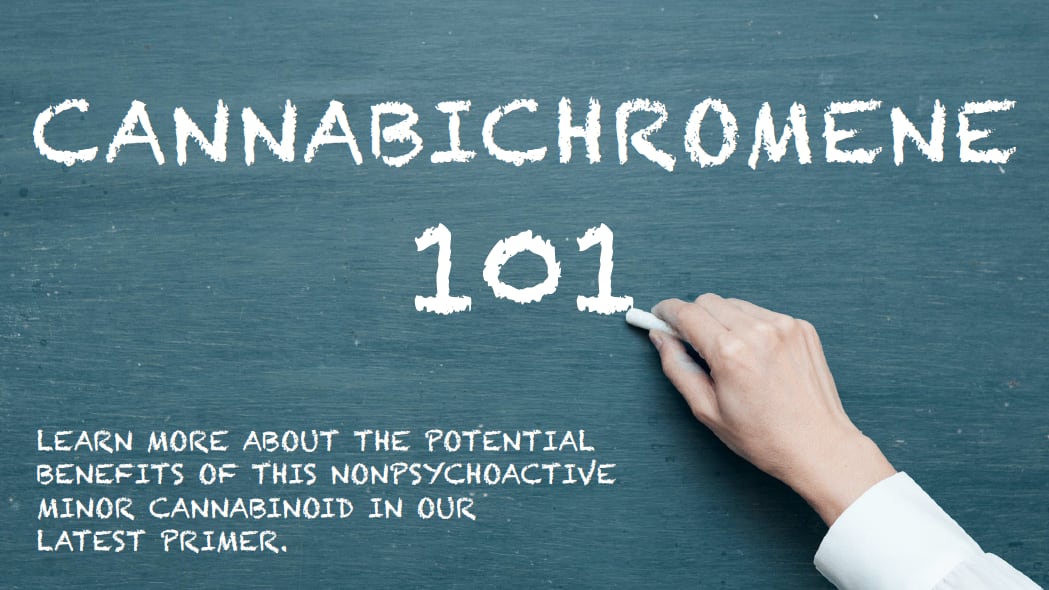Despite all of the exciting discoveries made in the cannabis industry, we’ve really only scratched the surface of weed’s holistic capabilities.
This era’s normalization of cannabis has really widened our contemporary understanding of the plant’s therapeutic potential. Modern cultivation, extraction and isolation techniques have changed how a lot of people view pot, and now more than ever, folks want to know how they can use it to improve and maintain their health.
Take, for instance, cannabichromene. This nonpsychotropic minor cannabinoid is the plant’s third-most prevalent phytocannabinoid, just behind THC and CBD, and has great potential to be a potent, side effect-free antidepressant. More exciting still, studies show that cannabichromene can shrink cancer cells and act as a neuroprotectant, protecting the aging brain against Alzheimer’s.
Cannathusiasts with therapeutic curiosity and rec users alike might consider how they can incorporate this potent pain-, inflammation- and depression-relieving cannabinoid into their wellness routines. Here’s an easy rundown to get you started:
What is cannabichromene?
In the lexicon of cannabinoid abbreviations, cannabichromene is known as CBC. This minor cannabinoid is one of the “big six” known cannabinoids: THC, CBD, CBG, CBN, THCV and CBC. Like THC and CBD, CBC’s precursor is CBGA, meaning those three cannabinoids develop similarly as the plant matures. CBC, however, affects the body through a different set of endocannabinoid receptors and, as such, produces similar yet critically different results.
CBC binds with two cannabinoid receptors linked to how we experience pain and may be nearly 10 times as effective as CBD for relieving pain, anxiety and inflammation. The cannabinoid has also shown significant antiviral and anti-tumor properties. Though it’s most effective as part of an entourage, CBC alone has tremendous therapeutic potential.
What does cannabichromene do?
CBC was discovered nearly 50 years ago, but it was in 2006 that a study showed the cannabinoid’s promise as a cancer fighter. Researchers looked at cannabinoids other than THC and their possible effects on cancer and found CBC to be the second-most potent cannabinoid at inhibiting the growth of new cancer cells (following CBG).
CBC also shows tremendous promise as a neuroprotectant, supporting and maintaining brain homeostasis. A 2013 study showed the cannabinoid’s effect on neural stem progenitor cells as remarkably positive. Those cells differentiate into astroglial cells, which not only control neurotransmitters, but also protect against the types of inflammation and oxidative stress that create neurological issues such as Alzheimer’s disease.
Strains with high concentrations of CBC
CBC is still technically a novel cannabinoid, which is to say there’s much to learn about how it interacts with the human body and can be cultivated to fulfill that potential. In the meantime, though, medicinal strains bred for high CBD content and low THC content can often have high concentrations of CBC as well. The following relatively ubiquitous therapeutic strains all have a significant percentage of CBC:
Charlotte’s Web
Named for Charlotte Figi, the child whose rare seizure disorder was managed with the cultivar, Charlotte’s Web is a low-THC, high-CBD strain developed by Colorado breeders Stanley Brothers. Since it’s derived from industrial hemp, it’s nonintoxicating. That said, the strain does have some energizing characteristics. Depending on the user’s endocannabinoid makeup, this could be a peppy or relaxing strain, so proceed with caution.
BUY: Puddletown Organics, 8201 SE Powell Blvd., 503-558-6321, puddletownorganics.com.
Sour Tsunami
Another cultivar bred for its therapeutic potential is Sour Tsunami, a cross of NYC Diesel and Sour Diesel. This strain is also high in CBD and low in THC, and does not produce a psychotropic “high” per se, but does deliver relief from chronic pain, insomnia, appetite loss and, perhaps most importantly, severe epilepsy. Rec users, take note: Though this strain isn’t psychotropic, it’s phenomenally soothing and has a top-shelf, gassy AF terpene profile, perfect for easing into or out of a tolerance break.
BUY: Love Buzz, 5425 NE Glisan St. (inside Acme Comics), 971-754-4977, lovebuzzpdx.com.
Black Cherry Soda
While other therapeutic strains have higher concentrations of CBD and lower concentrations of THC, Black Cherry Soda presents a balanced profile that does, in fact, deliver a spacey head high and gently effervescent body high. Those balanced effects make it a favorite of stoney patients who require functional medication throughout the day but want to avoid the sometimes sedative effects found in other CBD-heavy therapeutic cultivars.
BUY: Cannabliss & Co., 2231 W Burnside St., 971-279-5570, chalicebrandsltd.com.
